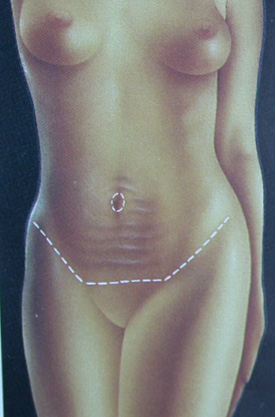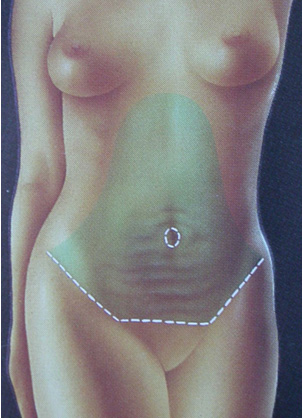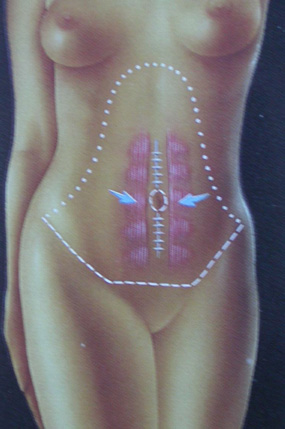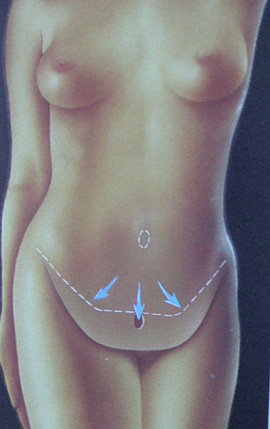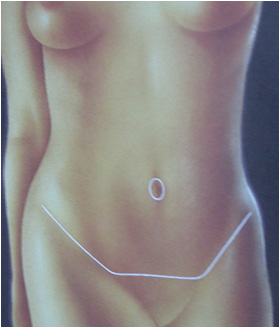Abdominoplasty, commonly known as “Tummy Tuck” is an important surgical procedure performed to remove the excess skin and fat in the mid and lower abdominal region, and to tighten the abdominal wall muscles. This surgical procedure is intended to improve the appearance dramatically by reducing the excess protruding part of the abdomen. It should be noted that this surgical procedure will leave a scar hidden by underwear.
The noticeability of the scar that may extend from one hip to another differs depending on the main problem of the person and the extent of the surgical operation required for correction. If you consider abdominoplasty, this brochure will give you basic information about when it might benefit you, how it is performed, and what results you can expect. This brochure cannot answer all of your questions, as there are many things depending on patients and surgeons. If there is anything you don’t understand, please ask your surgeon.
Best candidates for abdominoplasty...
Any man and woman whose body does not respond to diet and exercise, who has slack abdominal skin, or who is not satisfied with his/her appearance despite having a good shaped body just due to excess fat are the best candidates for abdominoplasty. This surgical procedure helps especially the abdominal muscles and skin of woman, who have had multiple births, to return to their conditions before pregnancy, after the postpartum recovery period. It can also improve lost skin elasticity and muscle tightness in many elderly patients who are moderately obese.
Patients who plan to lose weight to a considerable extent can delay the operation. In addition, women who plan to get pregnant in the future should wait for the completion of the pregnancy period, considering the fact that the vertical muscles in the abdomen which are tightened during this surgery will get separated again during pregnancy. If you have already scars left by any previous abdominal surgery, your surgeon may not recommend abdominoplasty or may take precautions to prevent the formation of abnormally protruding scars.
Although abdominoplasty partially restores your previous appearance and self-confidence, it will not achieve a great success compared to your ideal condition and will not cause people to treat you differently. Before deciding on this surgical procedure, you should carefully review your expectations and discuss the subject with your surgeon.
All surgical procedures carry risks.
Every year thousands of abdominoplasty operations are performed successfully. It usually gives positive results, when performed by a qualified plastic surgeon who has received training on the contours of the body. However, there are always potential risks involved in any surgical operation, as well as specific complication risks associated with this surgical procedure.
|
|
|
| Figure 1: It is possible to remove the excess skin and fat by making an incision just above the pubic region. | Figure 2: The abdominal skin is pulled up to the ribs. |
Despite being rare, postoperative complications such as infection and blood clots may be observed. Infections can be treated with drainage and antibiotics, but this causes prolonged hospital stay. You can minimize the risk of postoperative clotting even by just moving when you are in the bed.
A second surgery may be required for scars in case of poor recovery. Smokers are advised to stop smoking because it increases both the risk of complications and the risk of delayed recovery. You can help reduce the risk of complications by following your physician's instructions on the preoperative and postoperative periods. You should pay attention to the instructions on when and how to start physical activities, in particular.
Planning the Surgery.....
When the consultation starts, your physician first evaluates your medical condition, locates the fat deposits in your abdominal area, and carefully examines the skin color. If you smoke, receive medical treatment, take vitamins or any other type of medication, be sure to report all these to your physician.
|
|
|
| Figure 3: The rectus muscles of the abdominal wall are brought closer to the midline, and then are sutured together to provide tightening effect. | Figure 4: The excess skin is pulled downward and removed. |
Speak frankly when talking with your physician about your expectations. Your physician will be equally frank when explaining the alternatives, risks and their possible limits. For example, if there is an excessive increase in your fat deposits under your belly button, you need a simpler surgical procedure called mini-abdominoplasty. On the other hand, it could be more useful to perform liposuction in addition to mini or full abdominoplasty for being able to get rid of the excess fat in the hips and achieve a better appearance. Perhaps, liposuction alone can give the best result.
In any case, your surgeon will strive together with you to recommend the most appropriate procedure for you and will aim at achieving the best results close to the body contours you want to have.
During the consultation, your physician will give you information about the type of anesthesia, the facilities of the place where the surgery will be performed, and the costs.
|
|
| Figure 4: The position of the scars on the abdomen, which will remain after abdominoplasty. |
Preoperative Preparation.....
Your physician will give you information about eating, drinking, smoking, and the use or cessation of certain vitamins or medications. If you smoke, you should stop at least one or two weeks before surgery, and should not smoke for at least two weeks after surgery. Avoid excessive exposure to direct sunlight and do not diet before surgery, because both of these disrupt your recovery. If you have a cold or any type of infection, your physician will probably postpone the surgery.
Find a patient accompanist who will take you home when you are discharged after the surgery, and who will help you go out on the second or third postoperative day if you need.
Where will your surgery be performed...?
Many physicians perform both mini and full abdominoplasty procedures in a surgical center or a fully equipped hospital.
Types of Anesthesia.....
Physician usually prefer general anesthesia, which will enable you to sleep throughout operation.
Some physicians, on the other hand, use sedative drugs in conjunction with local anesthesia to numb the surgical site. When you come out of anesthesia, you feel comfortable and don’t have pain in the abdominal region. (however, you may still feel some strong contractions and discomfort)
Surgery...
An abdominoplasty operation takes 2 to 5 hours, depending on the extent of the work to be done.
Usually a long incision is made in the pubic region between the hip bones. A second incision is added to this incision to free the belly from its surrounding tissue. In mini abdominoplasty, on the other hand, even if the belly is not in its natural shape and even if the skin is stretched and sutured, the incision is shorter and the belly is not touched.
The physician then pulls the sagging skin upward to expose the vertical muscles of the abdomen, and pulls the skin of the abdominal wall towards the ribs in all directions. Since all these muscles are pulled together and sutured are used to keep them in their new positions, they get tightened. This treatment narrows the waist area and strengthens the abdominal wall.
The sagging skin is stretched downwards, and then its excess part is removed. A new hole is made for the navel, and then it is sutured. Finally, the long incision is closed and wrapped with bandage, and temporary drains are placed to discharge excess fluid from the surgical site.
In mini abdominoplasty, the skin is lifted only in the area between the incision line and the navel. The sagging skin is pulled downward, the excess part of skin is removed, and then the incision in this area is sutured.
After Surgery...
In the first postoperative days, you will probably have slight abdominal swelling as well as pain and discomfort that can be controlled with medication. You may be discharged a few hours after surgery or may need to stay in the hospital for a couple of days, depending on the extent of the surgery. Your physician will give you the required instructions on how to change your clothes and how to take a bath. Initially, you will not be able to sit upright. You should start walking as soon as possible.
The sutures on the surface will be removed 9-12 days after surgery and the deeper self-dissolving sutures that do not extend outside the skin will melt spontaneously. The bandage on the incision will be replaced with supportive equipment.
Returning to Normal.....
It may take weeks or months for you to start feeling like before the surgery again. If you do exercises intended for strengthening the abdominal muscles, this time will be shorter. Some patients return to work after 2 weeks, while some others need to rest for 3 to 4 weeks for being able to regain their health.
Exercises help you feel better. Even those who have never exercised before should start exercising to reduce swelling and the risk of coagulation. You should avoid strenuous exercises until you begin to do the moves easily.
For the first 3 to 6 postoperative weeks, until your scars heal, the appearance can be really bad but this is quite normal. It takes 3 to 5 months for your scars to flatten and fade in color. These scars never completely disappear, but abdominal scars do not attract attention as they remain hidden under the underwear.
Your new appearance...
When performed on patients with weak abdominal muscles or excess skin, mini or full abdominaplasty gives perfect results. A regular diet and exercise program ensures good results to last longer in many patients.
If your expectations about positive results and scarring are realistic, and if you feel ready for a long-term recovery period, abdominoplasty could be the right choice for you.
Prof.Dr. Serdar Öztürk

